1999 SUBARU LEGACY low oil pressure
[x] Cancel search: low oil pressurePage 996 of 1456

ICheck the area where the nut joins the tube.
G4M0614
3) Check the area of the sight glass and pressure
switch (dual switch), and also check the seams of
the receiver drier.
4) Check the connections of the tubes to the
condenser, and also check any welded joints on
the condenser.
CAUTION:
An oily area on the fins of the condenser may
indicate a leak.
5) Check the area where the hoses attach to the
compressor.
6) Check around the machined portions of the
compressor (where the compressor sections join
each other).
7) If equipped, check the thermal limiter on the
compressor housing.
8) Check the compressor shaft seal by probing
near the center of the compressor clutch pulley.
NOTE:
Some shaft seals have a very slight amount of
normal leakage [approximately 28 g (1.0 oz) per
year].
5. LEAK TEST (LOW-PRESSURE SIDE)
1) Begin at the connection of the low-pressure
tube to the evaporator, and work your way along
the low-pressure of the system to the compressor.
There are three places to check on each tube con-
nection.
2) Check the area.(1) Check the area where the fitting joins the
tube.
G4M0615
(2) Check the area where the two parts of the
fitting join each other.
(3) Check the area where the nut joins the tube.
G4M0616
6. CHECK THE FLEXIBLE HOSES
Visually inspect the rubber portions of the flexible
hoses for cracking. Probe the rubber section,
including the ends of any insulators or protectors
which may cover sections of the rubber hose, and
near the ends where the rubber meets the metal
collar.
NOTE:
Be certain to move the probe slowly [approximately
25 mm (1 in) per second] when probing along any
length of hose or tube.
G4M0617
20
4-7[W8A5]SERVICE PROCEDURE
8. Leak Testing
Page 997 of 1456
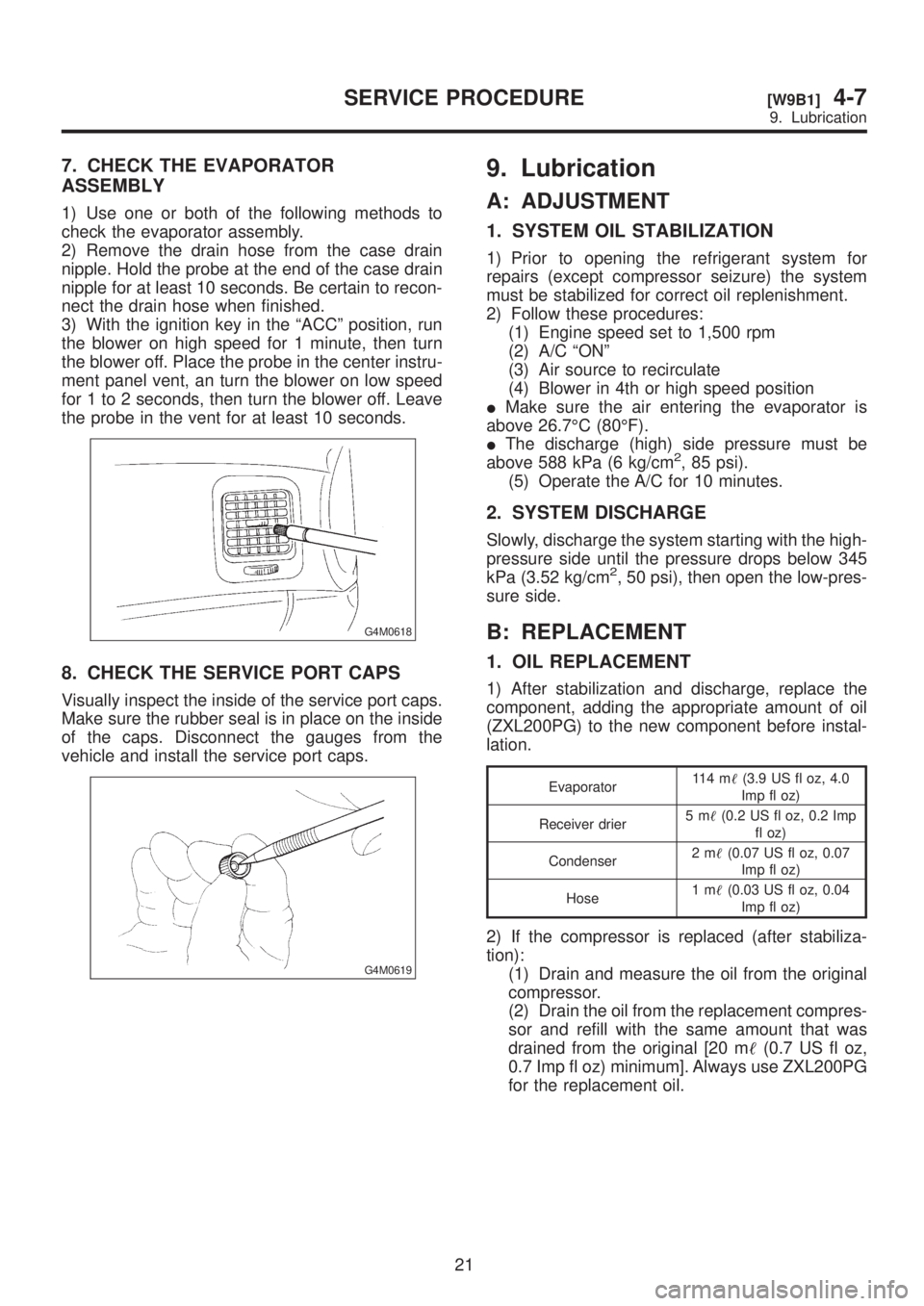
7. CHECK THE EVAPORATOR
ASSEMBLY
1) Use one or both of the following methods to
check the evaporator assembly.
2) Remove the drain hose from the case drain
nipple. Hold the probe at the end of the case drain
nipple for at least 10 seconds. Be certain to recon-
nect the drain hose when finished.
3) With the ignition key in the ªACCº position, run
the blower on high speed for 1 minute, then turn
the blower off. Place the probe in the center instru-
ment panel vent, an turn the blower on low speed
for 1 to 2 seconds, then turn the blower off. Leave
the probe in the vent for at least 10 seconds.
G4M0618
8. CHECK THE SERVICE PORT CAPS
Visually inspect the inside of the service port caps.
Make sure the rubber seal is in place on the inside
of the caps. Disconnect the gauges from the
vehicle and install the service port caps.
G4M0619
9. Lubrication
A: ADJUSTMENT
1. SYSTEM OIL STABILIZATION
1) Prior to opening the refrigerant system for
repairs (except compressor seizure) the system
must be stabilized for correct oil replenishment.
2) Follow these procedures:
(1) Engine speed set to 1,500 rpm
(2) A/C ªONº
(3) Air source to recirculate
(4) Blower in 4th or high speed position
IMake sure the air entering the evaporator is
above 26.7ÉC (80ÉF).
IThe discharge (high) side pressure must be
above 588 kPa (6 kg/cm
2, 85 psi).
(5) Operate the A/C for 10 minutes.
2. SYSTEM DISCHARGE
Slowly, discharge the system starting with the high-
pressure side until the pressure drops below 345
kPa (3.52 kg/cm
2, 50 psi), then open the low-pres-
sure side.
B: REPLACEMENT
1. OIL REPLACEMENT
1) After stabilization and discharge, replace the
component, adding the appropriate amount of oil
(ZXL200PG) to the new component before instal-
lation.
Evaporator11 4 m(3.9 US fl oz, 4.0
Imp fl oz)
Receiver drier5m(0.2 US fl oz, 0.2 Imp
fl oz)
Condenser2m(0.07 US fl oz, 0.07
Imp fl oz)
Hose1m(0.03 US fl oz, 0.04
Imp fl oz)
2) If the compressor is replaced (after stabiliza-
tion):
(1) Drain and measure the oil from the original
compressor.
(2) Drain the oil from the replacement compres-
sor and refill with the same amount that was
drained from the original [20 m(0.7 US fl oz,
0.7 Imp fl oz) minimum]. Always use ZXL200PG
for the replacement oil.
21
[W9B1]4-7SERVICE PROCEDURE
9. Lubrication
Page 998 of 1456
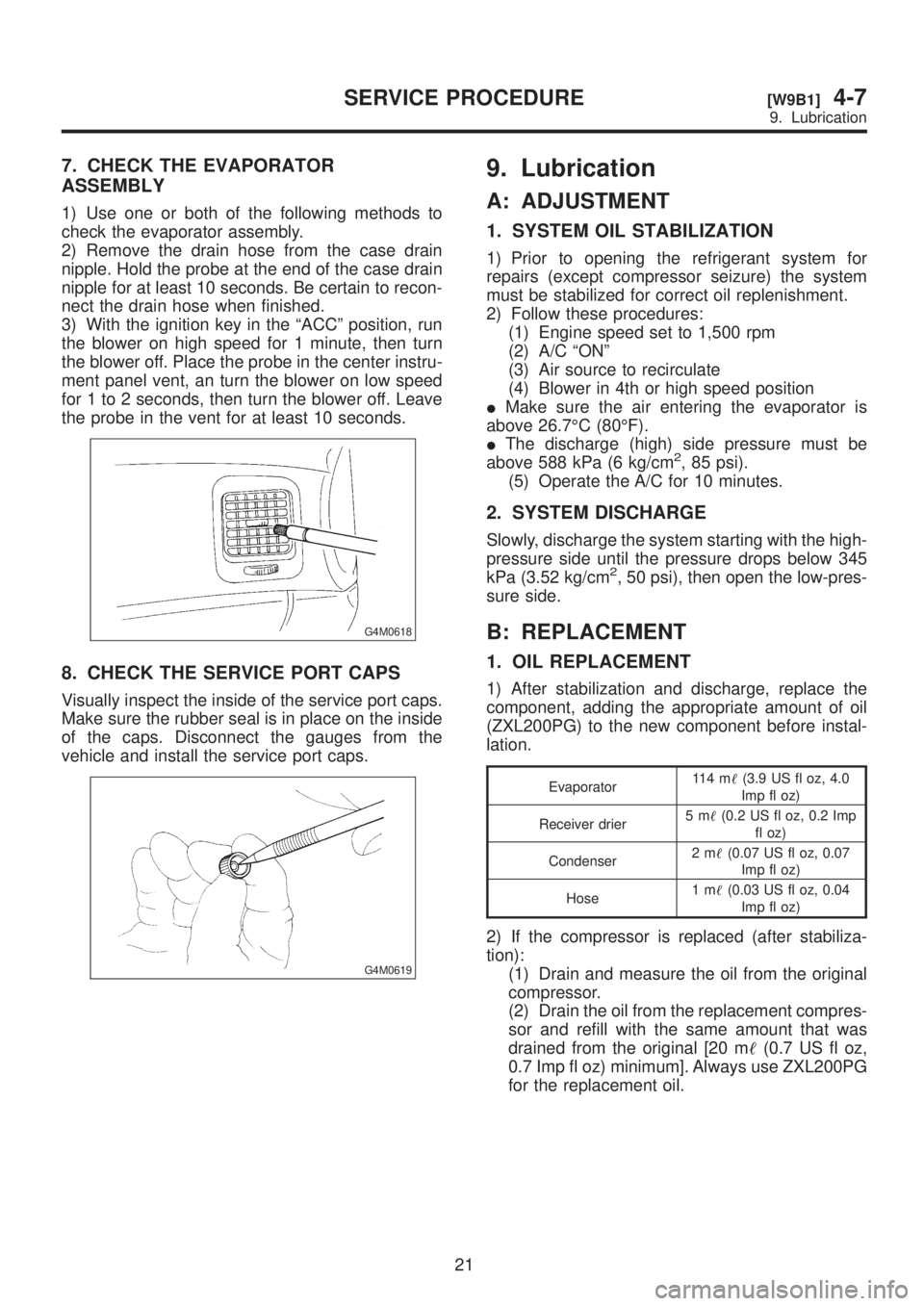
7. CHECK THE EVAPORATOR
ASSEMBLY
1) Use one or both of the following methods to
check the evaporator assembly.
2) Remove the drain hose from the case drain
nipple. Hold the probe at the end of the case drain
nipple for at least 10 seconds. Be certain to recon-
nect the drain hose when finished.
3) With the ignition key in the ªACCº position, run
the blower on high speed for 1 minute, then turn
the blower off. Place the probe in the center instru-
ment panel vent, an turn the blower on low speed
for 1 to 2 seconds, then turn the blower off. Leave
the probe in the vent for at least 10 seconds.
G4M0618
8. CHECK THE SERVICE PORT CAPS
Visually inspect the inside of the service port caps.
Make sure the rubber seal is in place on the inside
of the caps. Disconnect the gauges from the
vehicle and install the service port caps.
G4M0619
9. Lubrication
A: ADJUSTMENT
1. SYSTEM OIL STABILIZATION
1) Prior to opening the refrigerant system for
repairs (except compressor seizure) the system
must be stabilized for correct oil replenishment.
2) Follow these procedures:
(1) Engine speed set to 1,500 rpm
(2) A/C ªONº
(3) Air source to recirculate
(4) Blower in 4th or high speed position
IMake sure the air entering the evaporator is
above 26.7ÉC (80ÉF).
IThe discharge (high) side pressure must be
above 588 kPa (6 kg/cm
2, 85 psi).
(5) Operate the A/C for 10 minutes.
2. SYSTEM DISCHARGE
Slowly, discharge the system starting with the high-
pressure side until the pressure drops below 345
kPa (3.52 kg/cm
2, 50 psi), then open the low-pres-
sure side.
B: REPLACEMENT
1. OIL REPLACEMENT
1) After stabilization and discharge, replace the
component, adding the appropriate amount of oil
(ZXL200PG) to the new component before instal-
lation.
Evaporator11 4 m(3.9 US fl oz, 4.0
Imp fl oz)
Receiver drier5m(0.2 US fl oz, 0.2 Imp
fl oz)
Condenser2m(0.07 US fl oz, 0.07
Imp fl oz)
Hose1m(0.03 US fl oz, 0.04
Imp fl oz)
2) If the compressor is replaced (after stabiliza-
tion):
(1) Drain and measure the oil from the original
compressor.
(2) Drain the oil from the replacement compres-
sor and refill with the same amount that was
drained from the original [20 m(0.7 US fl oz,
0.7 Imp fl oz) minimum]. Always use ZXL200PG
for the replacement oil.
21
[W9B1]4-7SERVICE PROCEDURE
9. Lubrication
Page 1001 of 1456

11. Compressor
A: INSPECTION
1. COMPRESSOR CLUTCH
NOTE:
ICompressor is a swash plate type. When trouble
occurs, replace compressor as a single unit.
ICompressor clutch trouble is often caused by
clutch slippage and noise. Check and take correc-
tive measures, as required.
1) Remove belt cover.
B4M0090
2) Compressor clutch trouble is often caused by
clutch slippage and noise. Check and take correc-
tive measures, as required.
Clearance:
0.3 Ð 0.6 mm (0.012 Ð 0.024 in)
B4M0091
3) Check that voltage applied to magnetic coil is at
least 10.5 volts.
4) When noise is noted, check that it originates in
either compressor or pulley bearing.
B: REMOVAL
1) Disconnect ground cable from battery.2) Discharge refrigerant using refrigerant recovery
system.
(1) Fully close low-pressure valve of manifold
gauge.
(2) Connect low-pressure charging hose of
manifold gauge to low-pressure service valve.
(3) Open low-pressure manifold gauge valve
slightly, and slowly discharge refrigerant from
system.
CAUTION:
Do not allow refrigerant to rush out. Otherwise,
compressor oil will be discharged along with
refrigerant.
B4M0760A
3) Remove low-pressure hose (a) and high-pres-
sure hose (b).
CAUTION:
IBe careful not to lose O-ring of low-pressure
hose.
IPlug the opening to prevent foreign matter
from entering.
B4M0761D
24
4-7[W11A1]SERVICE PROCEDURE
11. Compressor
Page 1004 of 1456
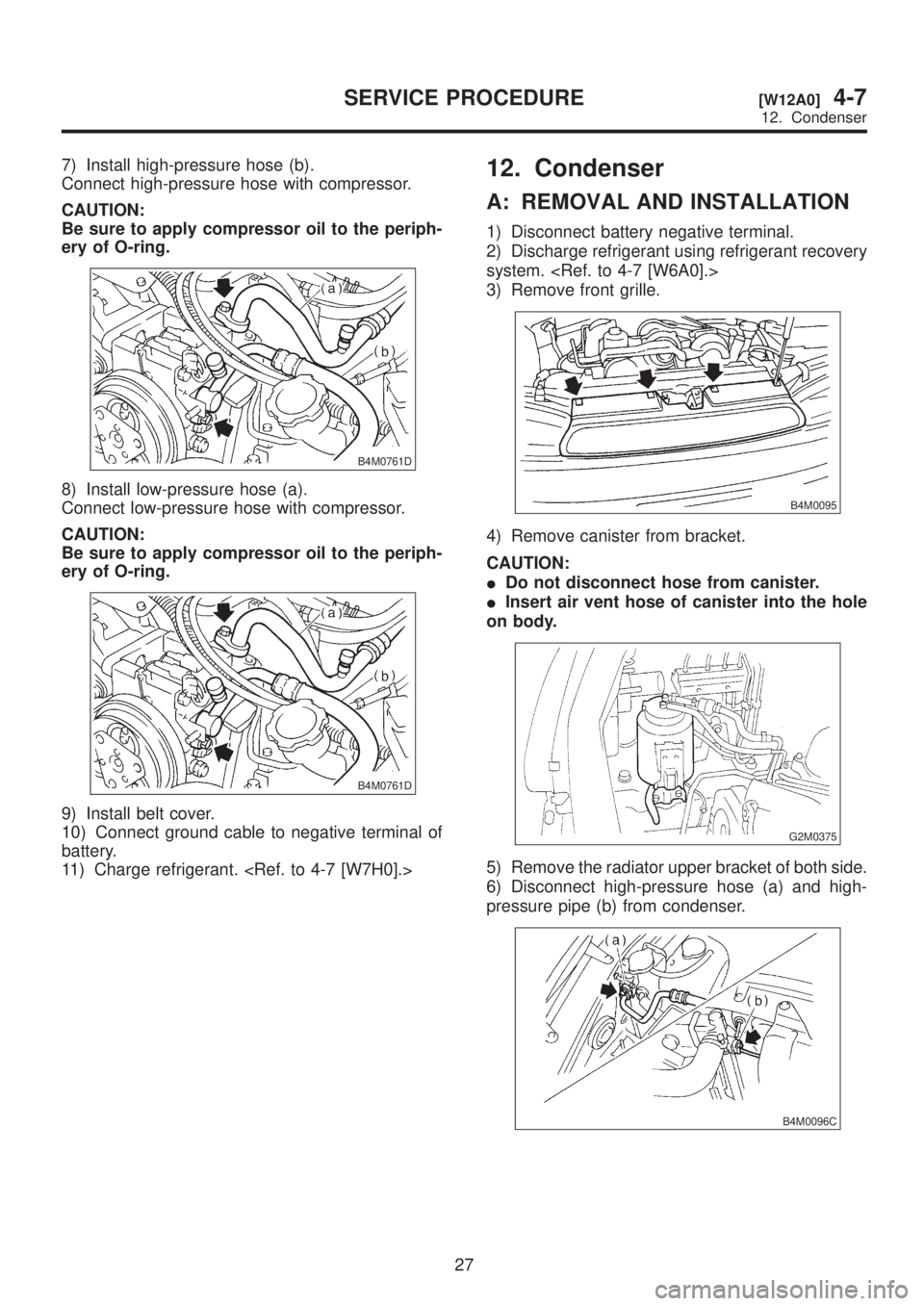
7) Install high-pressure hose (b).
Connect high-pressure hose with compressor.
CAUTION:
Be sure to apply compressor oil to the periph-
ery of O-ring.
B4M0761D
8) Install low-pressure hose (a).
Connect low-pressure hose with compressor.
CAUTION:
Be sure to apply compressor oil to the periph-
ery of O-ring.
B4M0761D
9) Install belt cover.
10) Connect ground cable to negative terminal of
battery.
11) Charge refrigerant.
12. Condenser
A: REMOVAL AND INSTALLATION
1) Disconnect battery negative terminal.
2) Discharge refrigerant using refrigerant recovery
system.
3) Remove front grille.
B4M0095
4) Remove canister from bracket.
CAUTION:
IDo not disconnect hose from canister.
IInsert air vent hose of canister into the hole
on body.
G2M0375
5) Remove the radiator upper bracket of both side.
6) Disconnect high-pressure hose (a) and high-
pressure pipe (b) from condenser.
B4M0096C
27
[W12A0]4-7SERVICE PROCEDURE
12. Condenser
Page 1005 of 1456
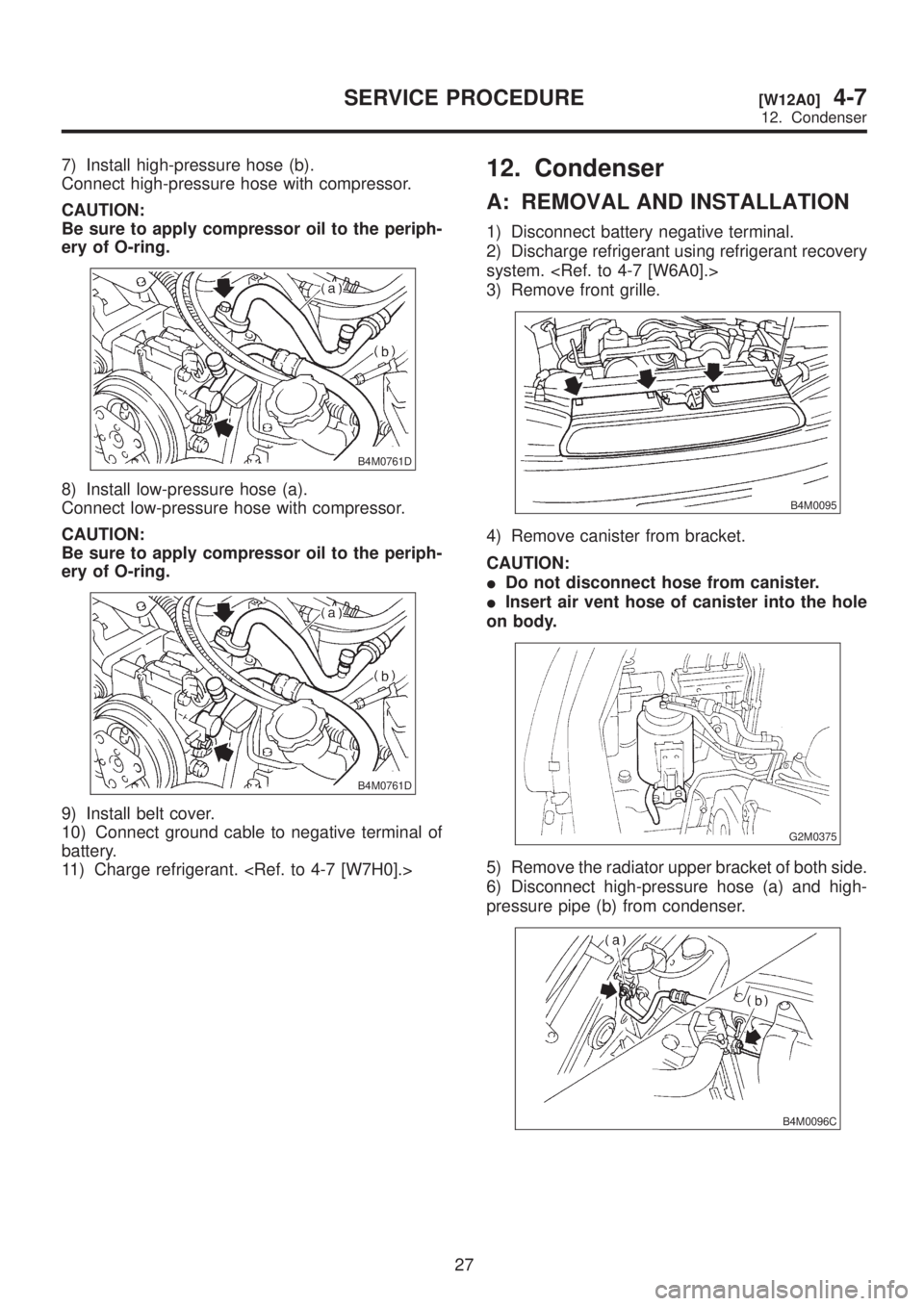
7) Install high-pressure hose (b).
Connect high-pressure hose with compressor.
CAUTION:
Be sure to apply compressor oil to the periph-
ery of O-ring.
B4M0761D
8) Install low-pressure hose (a).
Connect low-pressure hose with compressor.
CAUTION:
Be sure to apply compressor oil to the periph-
ery of O-ring.
B4M0761D
9) Install belt cover.
10) Connect ground cable to negative terminal of
battery.
11) Charge refrigerant.
12. Condenser
A: REMOVAL AND INSTALLATION
1) Disconnect battery negative terminal.
2) Discharge refrigerant using refrigerant recovery
system.
3) Remove front grille.
B4M0095
4) Remove canister from bracket.
CAUTION:
IDo not disconnect hose from canister.
IInsert air vent hose of canister into the hole
on body.
G2M0375
5) Remove the radiator upper bracket of both side.
6) Disconnect high-pressure hose (a) and high-
pressure pipe (b) from condenser.
B4M0096C
27
[W12A0]4-7SERVICE PROCEDURE
12. Condenser
Page 1006 of 1456
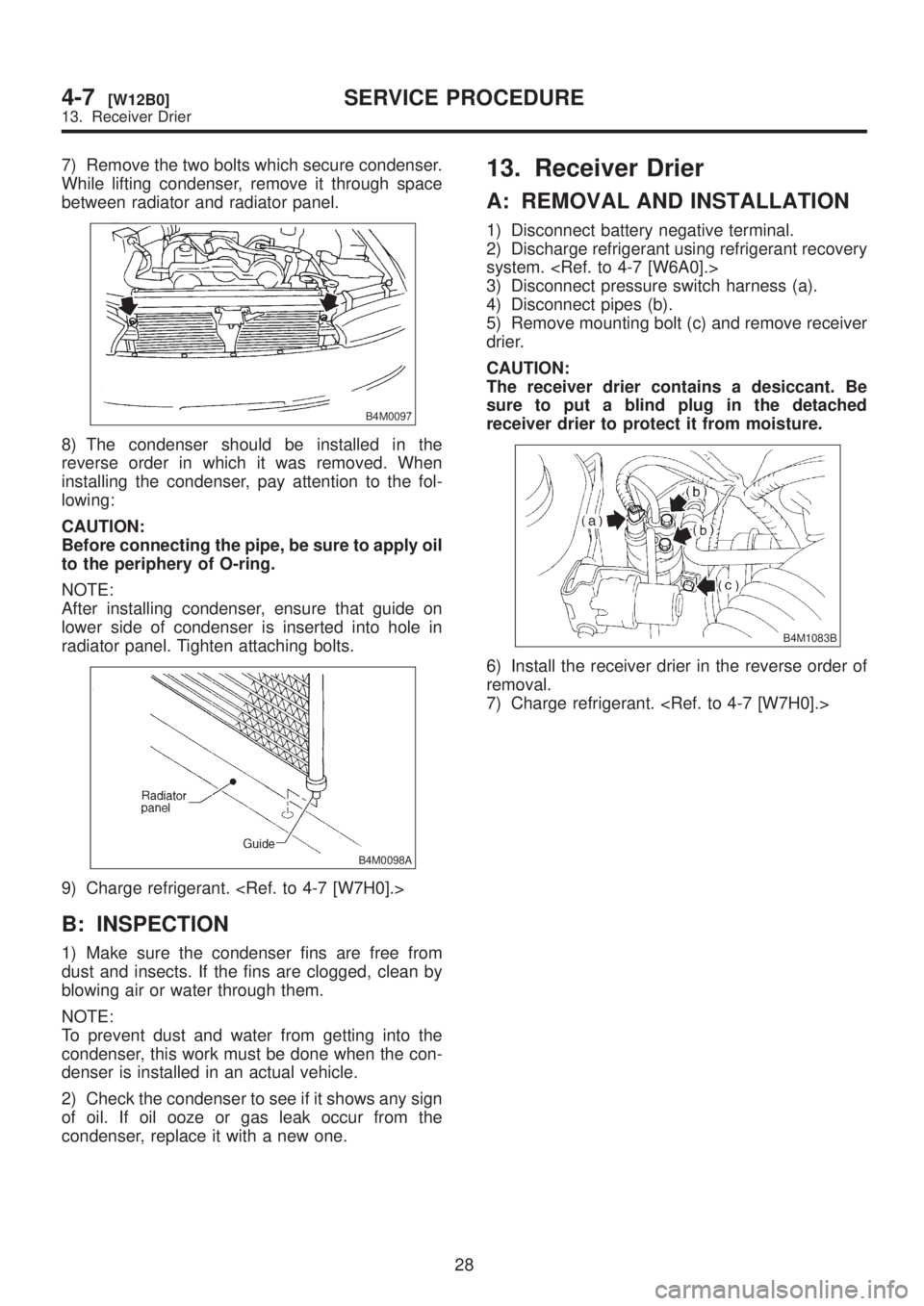
7) Remove the two bolts which secure condenser.
While lifting condenser, remove it through space
between radiator and radiator panel.
B4M0097
8) The condenser should be installed in the
reverse order in which it was removed. When
installing the condenser, pay attention to the fol-
lowing:
CAUTION:
Before connecting the pipe, be sure to apply oil
to the periphery of O-ring.
NOTE:
After installing condenser, ensure that guide on
lower side of condenser is inserted into hole in
radiator panel. Tighten attaching bolts.
B4M0098A
9) Charge refrigerant.
B: INSPECTION
1) Make sure the condenser fins are free from
dust and insects. If the fins are clogged, clean by
blowing air or water through them.
NOTE:
To prevent dust and water from getting into the
condenser, this work must be done when the con-
denser is installed in an actual vehicle.
2) Check the condenser to see if it shows any sign
of oil. If oil ooze or gas leak occur from the
condenser, replace it with a new one.
13. Receiver Drier
A: REMOVAL AND INSTALLATION
1) Disconnect battery negative terminal.
2) Discharge refrigerant using refrigerant recovery
system.
3) Disconnect pressure switch harness (a).
4) Disconnect pipes (b).
5) Remove mounting bolt (c) and remove receiver
drier.
CAUTION:
The receiver drier contains a desiccant. Be
sure to put a blind plug in the detached
receiver drier to protect it from moisture.
B4M1083B
6) Install the receiver drier in the reverse order of
removal.
7) Charge refrigerant.
28
4-7[W12B0]SERVICE PROCEDURE
13. Receiver Drier
Page 1007 of 1456
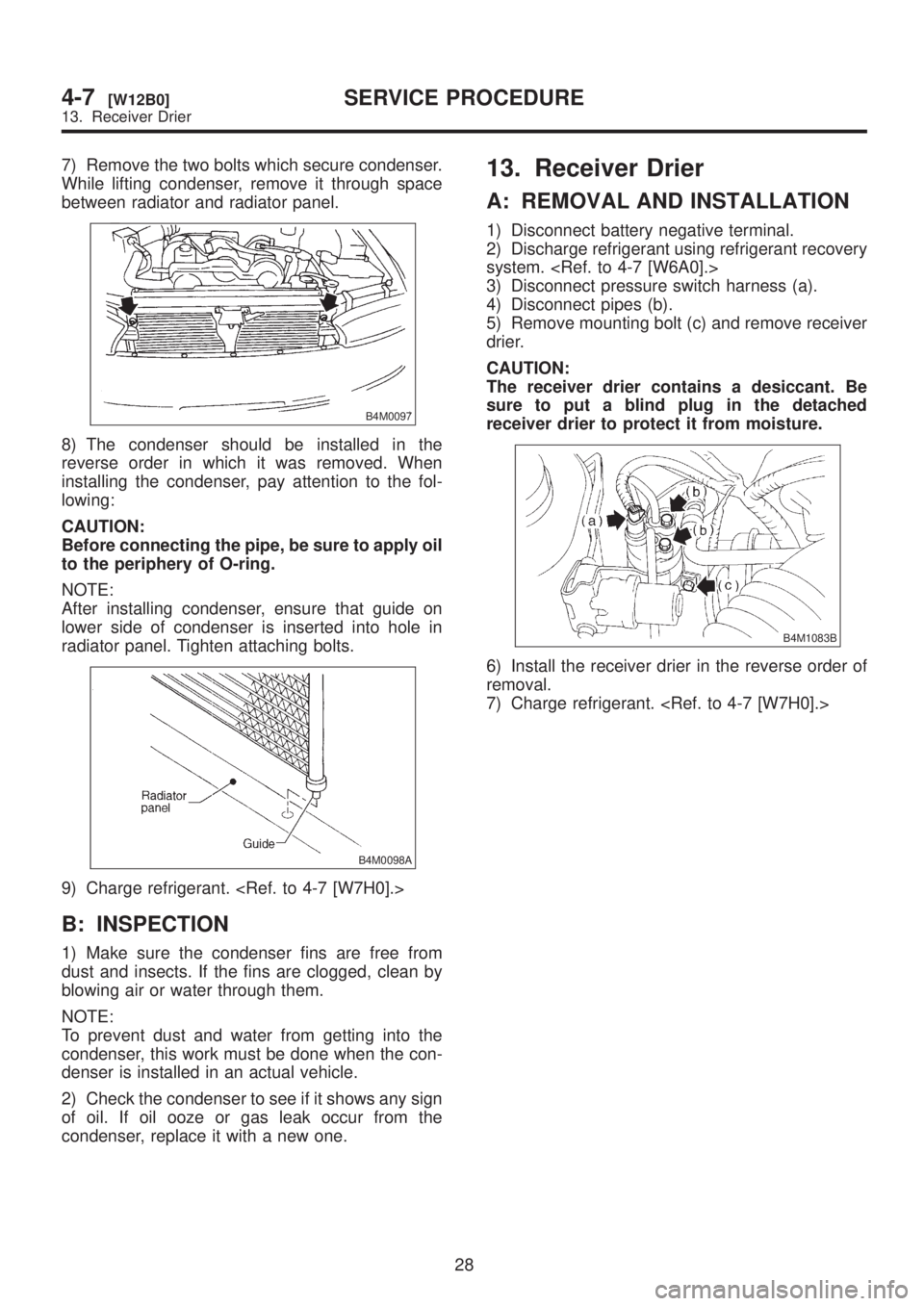
7) Remove the two bolts which secure condenser.
While lifting condenser, remove it through space
between radiator and radiator panel.
B4M0097
8) The condenser should be installed in the
reverse order in which it was removed. When
installing the condenser, pay attention to the fol-
lowing:
CAUTION:
Before connecting the pipe, be sure to apply oil
to the periphery of O-ring.
NOTE:
After installing condenser, ensure that guide on
lower side of condenser is inserted into hole in
radiator panel. Tighten attaching bolts.
B4M0098A
9) Charge refrigerant.
B: INSPECTION
1) Make sure the condenser fins are free from
dust and insects. If the fins are clogged, clean by
blowing air or water through them.
NOTE:
To prevent dust and water from getting into the
condenser, this work must be done when the con-
denser is installed in an actual vehicle.
2) Check the condenser to see if it shows any sign
of oil. If oil ooze or gas leak occur from the
condenser, replace it with a new one.
13. Receiver Drier
A: REMOVAL AND INSTALLATION
1) Disconnect battery negative terminal.
2) Discharge refrigerant using refrigerant recovery
system.
3) Disconnect pressure switch harness (a).
4) Disconnect pipes (b).
5) Remove mounting bolt (c) and remove receiver
drier.
CAUTION:
The receiver drier contains a desiccant. Be
sure to put a blind plug in the detached
receiver drier to protect it from moisture.
B4M1083B
6) Install the receiver drier in the reverse order of
removal.
7) Charge refrigerant.
28
4-7[W12B0]SERVICE PROCEDURE
13. Receiver Drier